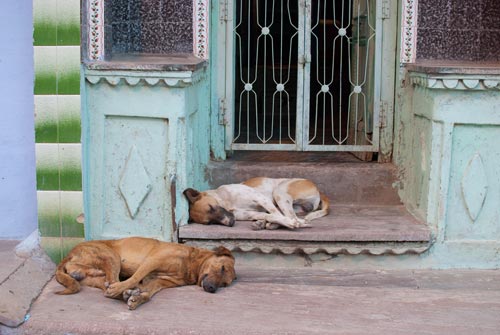
Keeping The Big Picture In Mind, Westerner Though I Be
There I was in the bathroom in the haveli (a large and ornately decorated traditional house) in which we were staying, trying to figure out how to transfer enough hot water with my water jug on to my hair to wash it for the first time in more than a week.
Now readers might think I was dealing with a ‘deprived’ situation in a remote region of India, and it’s true that the town of Bundi in which we were staying is poor, semi-rural, and semi-agricultural.
However, that would be thinking like a Westerner since the family who own that haveli as they have for generations are amongst the town’s privileged few.
So modern-day luxuries like hot water aside, this home had all the markings of great comfort: There were quite a large number of spacious rooms congregated around a cool courtyard of sorts surrounded by columns in the central part of the house.
In this town with unpaved roads where the vast majority of people have tiny, ramshackle shops and one-room hovels, such material comfort is an unattainable dream.
Chaff And Firewood
How most of the people live was evident only a few streets away from the privileged haveli.
For example, one day David spotted a woman separating the chaff from the wheat right outside her front door on an unmade road.
Another day we observed this woman walking down the town’s main drag with firewood balanced on a large aqua ring of cloth on her head:

The Local Hair Salon
Speaking of hair as I did before, here’s how the locals get spiffied up:
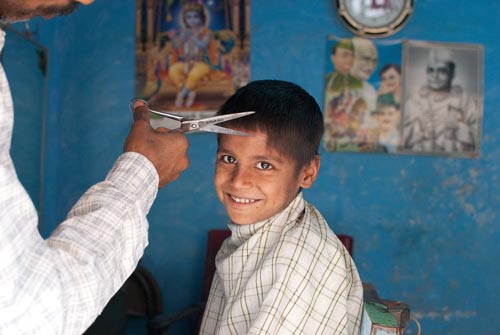
One sees such one-room hair salons dotted all over the country.
A Different Kind Of Style
One can also see wandering religious men called ‘sadhus’ on the streets of India, like this man here who had his face and hair covered in ashes as he tried to collect money to put in his golden bowl:
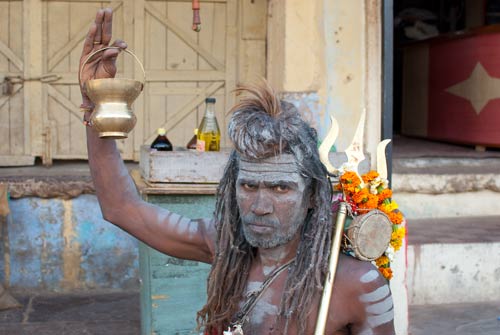
A Local Resident
As we walked on further after exchanging nods with this sadhu, here is a woman we spotted wearing a lovely sari as she called to a friend from outside the door of her home:
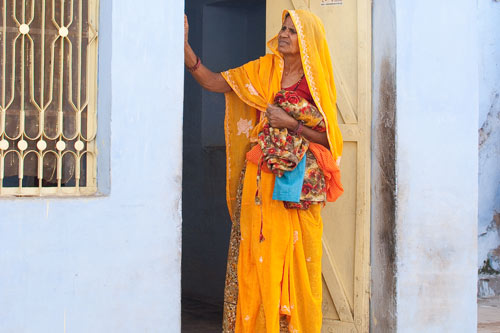
Delivering The Milk, Indian Style
As one street led to another, we then noticed this man (wearing a typical turban found in Rajasthan) who was delivering milk on his bike to individual houses.
To deliver the correct amount, he uses the jug with the long handle to decanter milk from gold and silver jugs that are fastened on to his bicycle, as you can see in this photograph:
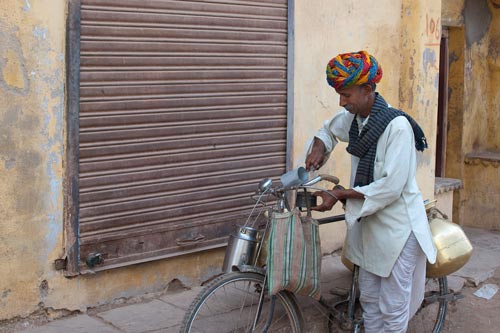
The Effect Of Climate Change On Milk Prices
A litre of milk currently costs 10 rupees (about 10 pence per litre or 8 cents a pint) in Bundi, which we were told is very expensive. The cost of milk in other parts of the country that are not near arable land can be more than twice as much as this.
We were told in Bundi that in recent years the monsoon rains have been failing, as we have seen ourselves around the country where water levels look a good deal lower than usual.
Not enough water means that the grass has not been growing well, which means the cows don’t have as much as usual to eat and ultimately this has meant less and more expensive milk is the only thing available.
Creating Cloth Of Many Colors
Just as milk is a staple in the country, so too is the availability of beautifully crafted cloth and clothing.
Even in a small town like Bundi, textiles are created as we saw when we came upon this elderly man:

Sitting on the floor as he worked with his hand loom, his tiny shop was festooned inside and out with the colourful shawls and saris that he had made by hand. When we talked with him, he told us that he has worked on his hand loom for decades. He was also proud to emphasize the quality of the cotton that he used.
All in all, we could see what a painstaking, exacting art it is for him and others who work on such hand looms as they create such items by hand.
The Face Of The Deserted Palace
After exploring the streets of Bundi, our haveli offered a welcome refuge from the heat of the town. The haveli we stayed at was overlooked by the palace, built by His Highness Rao Rajaratan Ji ho who ruled Bundi from 1607 to 1631, and situated just a couple of hundred yards up the steep hill behind the town. Now deserted, this palace juts out over the hills.
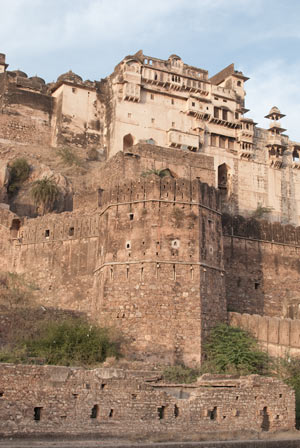
This photograph shows the steep path leading up to the palace and higher beyond the palace to the fort whose walls run along the top of the range of hills.
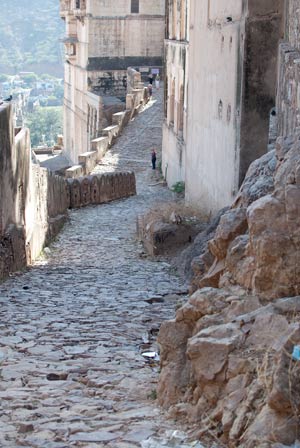
Current Residents Who Also Live Next To The Palace
Aside from the family who owns this haveli where we stayed, the place also has these other local residents who were living right outside the mesh wire protection that surrounds the haveli:
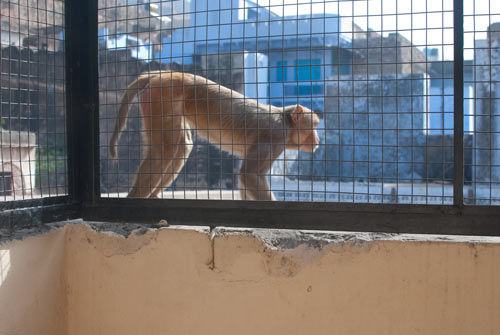
Look Before Leaping?
As you can see from the previous photographs, the other residents are actually macaques who are Old World monkeys.
Although of course I have seen monkeys in zoos, I have never seen monkeys in the wild as we have here in India. And from our vantage point in the room at this haveli, I could see the monkeys from behind as they leapt off from the ledges and walls that surround the building.
It was fascinating to watch them jump, and their positions reminded me of the way that some people who cannot swim sometimes jump into water with their arms and legs supporting their eventual fall into the water.
Managing Macaques
Although David and I were excited to see macaque families with parents and little ones living right outside our room with only the wire mesh that the haveli owner had put up between us and the monkeys, the reality for the haveli owner and his family was similar to what we heard throughout Bundi: Such monkeys can cause havoc by stealing or wrecking people’s food, clothing, and other possessions.
For this reason, we saw several people throughout the town (including members of the family who owned the haveli where we stayed) use air rifles around the animals to scare them off.
The Sobering Reality
Local people are wise to keep these monkeys at bay since according to current statistics, both wild and captive macaque populations generally have high rates of the herpes B virus infection.
Macaques are found all over India, often at close proximity to people just like they were at that colorful Bundi haveli.
So reading this statistic was sobering to me – and more than a bit sad since the monkeys are decidedly interesting characters to observe.